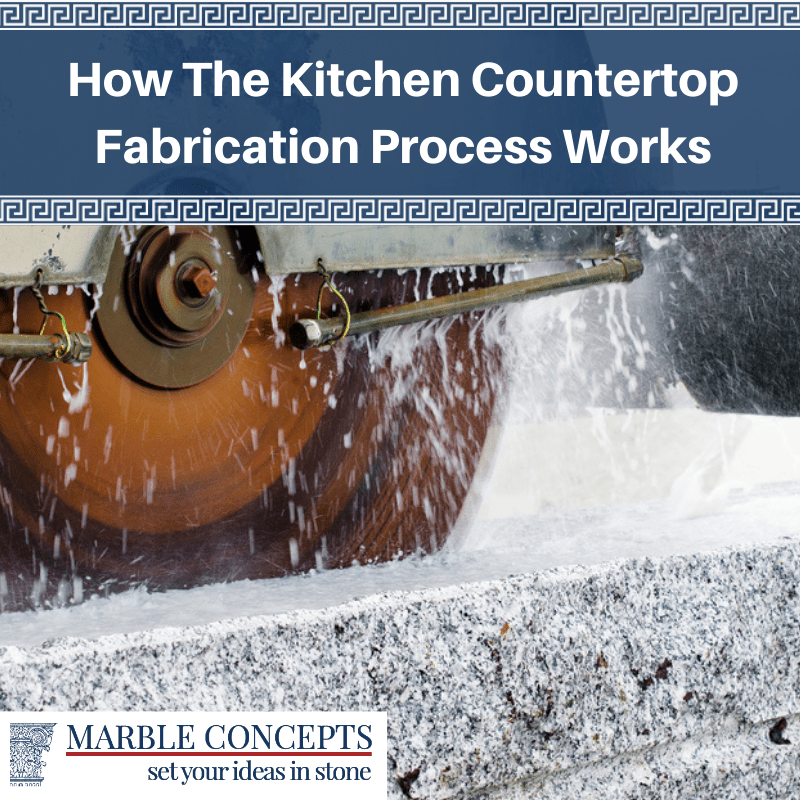After choosing a new countertop material for your kitchen, there are still several steps in the process. It is more involved than just selecting a nice material for your countertops. It takes time to turn these materials into a countertop. When you understand the process, you appreciate the timeless beauty of your new kitchen countertop.
The fabrication process is vital to help you get the right appearance for your countertops. All fabrication is completed by a professional. In many cases, the supplier specializes in the fabrication process, with all customizations completed at their shop. With that, you have a one-stop option that allows you to have control over the fabrication.
First Steps
Before fabrication can begin, you need to select the type of material for your countertop. There is a wide range of options, from natural stones to engineered materials. Once the stone has been chosen, the fabricator will come to your home and take measurements. The process starts by selecting a suitable slab for the project.
Slab Inspection
The next step of the process will involve your fabricator. This professional will inspect your chosen slab. Since stone is a natural product, there could be defects in the material. The fabricator makes sure there are no unacceptable characteristics in the stone. Before the stone is templated, there will also be a final inspection. This process involves the customer ensuring that the material meets their standards. The fabricator marks any unwanted spots to avoid them during the templating process.
Once the inspection is completed, a template is placed over the slab. These templates will ensure that the countertop has the best cut of stone. The templates are also arranged to make sure there is a flow to the countertops. For example, if there is an L-shaped countertop, the overall flow of the pattern must work in your kitchen. This step is essential when fabricating marble, granite, or quartz. With an experienced templater, you have a piece that exhibits natural beauty.
Cutting Your Stone
Now that the stone has been selected, inspected, and templated, it is time to cut the stone. The cutting process uses a bridge saw or water jet. Traditionally, the bridge saw was the preferred tool. However, the water jet saw has become a popular option. With these specialized saws and tools, you can achieve a high-quality look with your countertops.
A bridge saw uses a segmented diamond blade with a feed rate of 7 feet per minute. With a water jet, the tool uses high water pressure with a garnet to cut at a rate of 1 foot per minute. Water jets are used to cut circles or any other intricate patterns. A bridge saw will only cut in a straight line.
Fabricating
It is time for the fabrication. The cutouts for the sink, faucet holes, and cooktop are made during this stage. A CNC (computer numerically controlled) machine cuts the stone to 1/16 inch of its final size. Since every stone is different, working with an experienced fabricator is important. At this stage of the fabrication process, technology and artistry come together. Once the initial cuts are made, the machine creates the edges. An experienced fabricator can produce a variety of edges and cutouts for your countertop.
Your fabricator might strengthen the stone. However, not all fabricators will complete this step. If you have thinner countertops, the fabricator increases the strength of the stone. For example, rod slots are cut and inserted into the grooves of a marble countertop. The fabricator uses high-strength epoxy to encapsulate the materials. With this process, it can help minimize any cracking in the stone.
Remember that natural stone is strong. These slabs are designed to take the brunt of those kitchen activities. If your fabricator does not strengthen the stone, there is no need to worry. You still have a solid surface that will remain durable for the life of your kitchen.
Polishing
You are almost at the end of the fabrication process. In some cases, the slab’s face is already polished, and there is no need for additional work. For the most part, the fabricator will use a diamond polish pad to smooth down the slab’s edges. Polishing also helps to reduce any sharp surfaces or corners of the slab.
Sealing
It is almost time to install the finished product. The natural stone material is protected from anything that can damage the surface by applying a sealer. These sealers do not degrade in interior settings. However, with some stone materials, you may need to have it resealed every year. When that time comes, the fabrication company can come to your home and reseal the stone. With that, your countertops will look great for decades.
Quality Control Check
The last part of the process is the inspection of the stone. At this time, the fabricator will make sure the edges are uniform by inspecting how the light bounces off the angles. The color is also checked to ensure it matches other parts of the stone. Now the stone is ready to be installed in your home.
Installation
It is now time to see what the finished product looks like in your home. The fabrication team will make sure that the countertops are professionally installed. They will take time to fit the countertops in your kitchen. In no time, you can finally enjoy your new countertops.
How Long Does It Take To Fabricate a Countertop?
Typically, it can take a few days to a week for the fabrication process. If you have selected a unique stone, it can take time to order, fabricate, and install in your home.
Choose an Experienced Company for Fabrication
When you need a new countertop for your home, Marble Concepts is ready to help. We have over 30 years of experience in the industry. Our showroom features a wide variety of stones that we can fabricate for your specific needs. If you are searching for granite companies nearby, contact us. Schedule a consultation by calling 215-396-7393.






